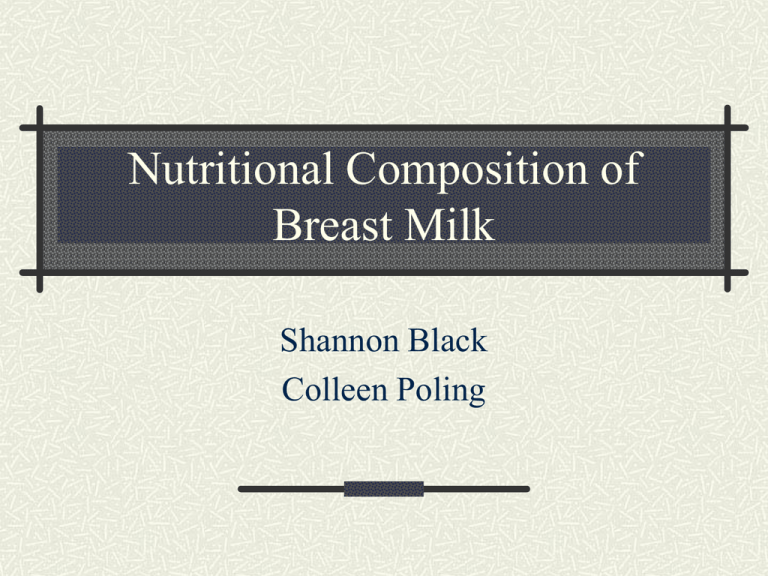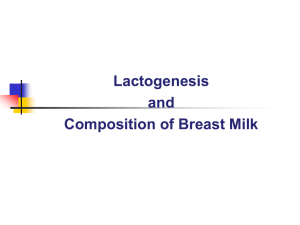Nutritional Composition of Breast Milk
advertisement

Nutritional Composition of Breast Milk Shannon Black Colleen Poling Human Milk Facts Isotonic Solution milk and plasma are of similar ion concentration Designed to protect infants chronic childhood diseases. T-lymphocytes, B-lymphocytes, neutrophils, macrophages and epithelial cells aid in protection Two forms of breast milk are colostrum and mature milk. Lactogenesis Lactogenesis is the production of human milk. Three phases: Lactogenesis I, II, III Colostrum in Human Milk Thick, yellow fluid Produced during lactogenesis II (2-3 days after birth) Provides 58-70 cal/100 ml High in protein, electrolytes, sodium, potassium, chloride and vitamin A Low in fat and carbohydrate Lactobacillus bifidus factor Mature Human Milk Thin and watery texture Forms during lactogenesis III Provides 2,730-2,940 cal/L High in linoleic acid and cholesterol content for brain development High in fat content and lactose Docosahexaenoic acids (DHA) Long chain omega-3 fatty acids. Used for synthesis of brain tissues, central nervous system and eyes DHA and cholesterol not found in human milk substitutes Mature Human Milk- PRO Protein Low content Dependent on infant’s age Antiviral and antimicrobial effects Casein Major protein in mature milk Casein, calcium phosphate, and other ions such as magnesium and citrate is what makes milk appear white. Mature Human Milk- CHO Lactose Disaccharide of galactose and glucose. Dominant carbohydrate in human milk. Enhances calcium absorption. Other carbohydrates Monosaccharides Glucose Polysaccharides Contribute calories Stimulate the growth of bifidus bacteria in the gut Inhibit the growth of E. coli and other bacteria Specific Nutrients in Human Milk Human Milk Composition (per liter) Milk Component Lactose (g) Total protein (g) Fat% Calories Retinol (mg) Caretenoids (mg) Riboflavin (ug) Niacin (mg) Vitamin B6 (mg) Pantothenic acid (mg) Biotin (ug) Folate (ug) Vitamin B12 (ug) Vitamin C (mg) Vitamin D (microgram) Vitamin E (mg) Vitamin K (microgram) Calcium (mg) Phosphorus (mg) Magnesium (mg) Copper (mg) Iron (mg) Zinc (mg) Early Milk 20-30 16 2 0 2 2 0 0.5 0 0 0 0 0 0 0 2-12 2-8 250 120-160 30-35 0.5-0.8 0.5-1.0 8-12 Mature Milk 67 9 3.5 2730-2940 0.3-0.6 0.3-0.6 400-600 1.8-6.0 0.9-0.31 2-2.5 5-9 80-140 .5-1.0 100 0.33 3-8 2-3 200-500 120-140 30-35 0.2-0.4 0.3-0.9 1-3 Change in Milk Composition During Feeding Foremilk Released first Higher in carbohydrate Lower in fat Hindmilk Resembles cream Higher in fat Lower in carbohydrate Released 10-20 minutes into the feeding Milk Supply and Demand First month postpartum About 2.5 cups per day of milk is produced 4-5 months postpartum About 3 cups produced per day Variations in milk production 1.8-5 cups per day for women nursing one infant Infant weight, caloric density of milk and infant’s age contributes infant’s demand for milk. Related Hormones Oxytocin This hormone causes the alveoli to contract and lets the milk flow. This is called the let down reflex Prolactin This hormone uses the alveoli to take the nutrients from the bloodstream and make it into milk. http://www.breastfeedingpartners.org/about _breastfeeding/aagstobaby.html Effects on breast milk composition Alcohol Nicotine Caffeine Marijuana and other drug abuse Environmental Exposures Genes Alcohol The alcohol transfers to the breast milk. If the mother consumes a lot of alcohol the baby will be directly affected. Slows let down reflex Not recommended Nicotine The nicotine in the milk is 1.5-3 times higher than in the blood. 10-20 cigarettes per day=.4-.5 mg of nicotine/L in blood No evidence of a health risk to the infant. Over time the infant could metabolize it in the liver and emit nicotine into kidneys Not recommended Caffeine A cup of coffee results in only low levels in the breast milk. It is ok to drink in moderation Marijuana and other drug abuse Marijuana, Amphetamines, cocaine, heroin and phencyclidine hydrochloride (PCP). Directly affect the infant directly and negatively. Also very harmful for mother Harmful because the contents of these substances are not uniform Each drug may include different amounts of bacteria, heavy metals, pesticides. Environmental Exposures Not routinely checked for environmental exposures. Being exposed to chemicals will most likely absorb and become part of the breast milk. Benefits outweigh the exposures. Avoid eating swordfish, king mackerel, rile fish, and shark from freshwaters that are contaminated, (reported by health agencies). Avoid exposure to paints, non-water based glues, furniture strippers, nail polish and gas fumes. Genes Different variations of Apolipoproteins can effect the amount of fat absorbed into the bloodstream and fat metabolism. These different variants effect the breast milk composition ApoA4: variants 347S and 347T (fat absorption) ApoE: variant E4 (fat metabolism) Benefits Breast fed babies vs. formula fed babies Positive health affects on mother Weight loss Delays menstruation Lower iron loss Decreasing risk of breast cancer Butyric Acid Cost and convenience Class Discussion What are the two forms of human milk? What form of milk is DHA most prevalent and what is its function? What is the main form of CHO in human milk and what is its function? What are the two main hormones involved with human milk production? What are some effects on human milk composition? Summary Lactogenesis Macronutrients of Colostrum Macronutrients of Human Milk Two major hormones and function Effects on human milk composition Benefits of breast feeding References http://www.news-medical.net/?id=10194 http://jds.fass.org/cgi/reprint/82/6/1339.pdf Brown, J. E. (2005). Nutrition Through the Life Cycle. Belmont, California: Thompson Learning, Inc..







